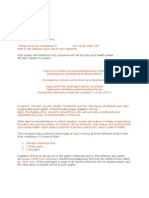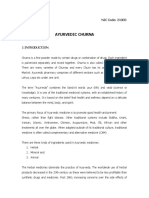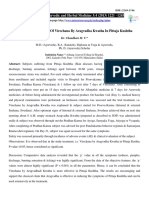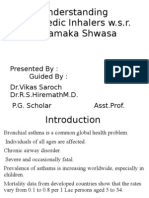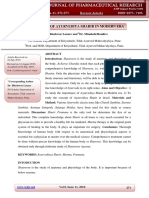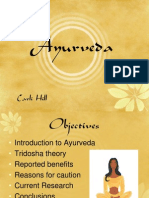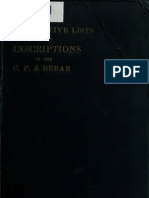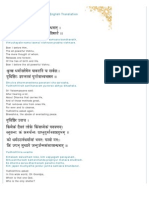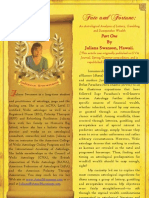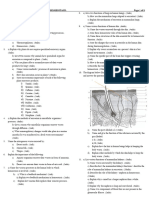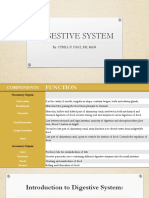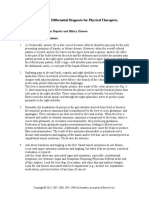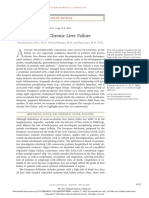Concept of Agni
Concept of Agni
Uploaded by
Kartik SrinivasanCopyright:
Available Formats
Concept of Agni
Concept of Agni
Uploaded by
Kartik SrinivasanCopyright
Available Formats
Share this document
Did you find this document useful?
Is this content inappropriate?
Copyright:
Available Formats
Concept of Agni
Concept of Agni
Uploaded by
Kartik SrinivasanCopyright:
Available Formats
CONCEPT OF AGNI IN AYURVEDA AND ITS IMPORTANCE
The metabolic function of Agni i.e. dehadhatwagni holds the same vital position in fundamental structure of the ayurvedic concept as that of the tridosas and this is amply demonstrated by well-known definition of swasthya, which equate the normality of dosic balance with that of Agni balance in an individual. Not only that, the importance of dehadhatwagni is further emphasized by the text when they described etiopathology of serious ailments. They described vitiation of the related Agni * In ayurveda Agni word oftenly come with the dehadhatwagni. Dehadhatu is one thats responsible for maintainence, protection and construction of body. Agni, on the other hand, is involved in the formation of various tissues. . In Bhagvad Gita, Lord Krishna says* aham vaisvanaro bhutva praninam deham asritah pranapana-samayuktah pacamy Annam catur-vidham "I am the fire of digestion in the bodies of all living entities, and I with the help of prana & apan, digest the four kinds of foodstuff."That is Bhaksya, Bhojya, Lehya, and Choshya. The Agni is called vaishavanaragni or sometimes jatharagni Sushruta called sadhakagni or sadhakpitta and narayanupanishada said like agni is situated in the heart and is responsible for maintaining the heat of the entire body. Further they describe this body has nine openings and circulatory systems. Jiva induced by his prarabdha makes effort to own his body after getting entrance in the space of heart. His first effort produced it and this is called ojas or
sadhakagni following which the pranas are created. Maharushi atraya called it aakashagni and susruta called it sadhakagni or sadhakpitta. The sounds produced by Agni are called jwala shubda it is sounding like bhak bhak. If you are aware of this similar sound, you can hear when you stand near by any boiler or chimney or any ygnakunda or when they pump the air in the boiler and ignite the fire, sound coming like bhak bhaksame sound you can hear in the body with your both hands closing the ears. So truly Punarvashu atreya also called it bad prognosis of pt. if he cant hear the sound like that. Modern physician consider this sound the heart beat. Anyways, back to the point, Agni according to ayurveda is an important concept for any physician who wants to treat pt. When we are talking about Agni, most of us think about digestive metabolism, we call it jatharagni. Does the word Agni means limited to jatharagni only or not? Its a little confusing. So many times ayurveda texts talks about agni that is jatharagni or pachakgni or pittagni, but in the whole context, agni is situated in the center of all anabolism and catabolism or one can say, all metabolism is Agni. In ayurveda text particularly charaksamhita or kaychikitsha they described 13 types of Agni. Five bhatukagni, seven dhatvagni and one jatharagni. They consider jatharagni is the center of all Agni * *2 Translation: lifespan, complexion, strength, health, enthusiasm, corpulence, luster, immunity, energy, heath process and vital breatheall these depends on body fire. One dies if his fire is extinguished. If it is functioning properly, one may live longs free from disorder. Get it ill if it is deranged hence Agni is the root cause of all for health. Panch bhutagni:According to the physical concept of ayurveda both the human body and food that goes to built our body, it is pancha bhautica in structure
.But inspite of the basic identity of ultimate components of food and consumer-human body, The final and finish protoplasmic matter are physically, physiologically and psychologically too different than the food. That agency has to be postulated to initiate the process of metabolism culminating in the conversion of the simple constitution of food into the highly complex and specialized human tissue. This agency consists of the 5 agnis of the respective 5 bhutas. Now we try to understand how each portion of the food disgest with respected Agni. 1. Digestion of aakash portion of foodsusruta called sathakagni and aakashagni are the same. Actually when the jivatma tries to manifest, Agni is produced even before the aakash came into the being. This sadhakagni is responsible for digestion of akashbhuta portion of food. No sooner, the food is digested then it reaches udhva amashaya and that increase the activity of the heart through which satakagni is transferred to the circulation and this Agni helps the digestion of aakash portion of the food. 2. Digestion of vayu portion: this Agni residing in the upper part of pakavasaya is responsible of digestion of vayu and call as vayagni. Maharushicharak quote that, samanagni seated as it is in the swadavaha and jalavaha strotas and bringing out of the bhrajakapitta of skin helps the digestion of vayu portion of our food when the vayu agni is uniformly spread the skin gets luster when the agni is deranged there is a decoloration of skin and disturbances in the sense of touchsparsha. Sense of touch is a function of vayu .Application of cold neutralize Agni induces vata pracopa in the form of shivering and application of heat relieves it. When a person got feared or terribly excited, there is a vaat prakopa we seen. Now this is a point of research to establish relation between adrenal secretion pumping and vagus nerve exertion ends in shivering the body and cooling of the extremities of the skin. How?
Another example, Why the application of cologne water reduces temperature of skin during fever. Why the application of brandy on the skin heats the body, we have to mind that they both have a unique quality of aakashguna evaporating. Brandy has the hidden heat so its application heats up the body and visa versa with cologne water. *3 3. Disgestion of tejus protion of food: Every type of Agni has tejus guna, then why is it a different tejus Agni? Because, it has a dominance of teja. The main function of tejus is prakash visual perception. Roop is the main quality. We all know that pitta seated in the eyes-aalochakpitta-is responsible for the visual perception. This Agni digest tejus portion of the food, but now the question is that what is the relation between allochakpitta seated in the eyes and pachakpitta produced by klom-pancreas. We all know about diabetic retinopathy. Why the Agni mandata seated in agnashaya pachakpitta reduces aalochakapitta and vice versa pachakpitta nourishes aalochakpitta *4* Yat Satve Yat Satvam anvayah, Yadbhave yadbhavo vyatirekah This unvaya vyatirac principle shows that pachakpitta nourishes aalochakpitta. So, susruta says pachakpitta which is secretion of pancreas is tejusagni. Tejus qualities are tikshna, Ruksha, ushna, vishad, lagu, tikta, katuvipik and daha paka and varnaprakashakburning digestive better for complexsion. Same as Chitraka, haldi, shilajatu have, so we use in this tejusagni kshya. There are many researches on insulin metabolism with our tejusagni. 4. Digestion of jaliya portion of food: Both charaka and susruta accept that rasa derived from digested food is transformed into rakta by means of particular Agni. This Agni also helps in the digestion of all other jaliya portion of food, namely in rusa rakta Lasika etc. Chakrapani also mentioned that the rusa derived after the amasaya is
circulated throughout the body by the action hridaya. Is separated of its mutra portion by gavini where after this rusa is called posyarasa, which nourishes all the dhatus. 5. Digestion of purthvi portion of food: Because food is punchmahabhuta, rasa and rukta derived from food, also punchamabhuta. Susruta shows the partihiva quality present in rukta purisha and pitta of pittashaya. When the quality of vishra is lost in purish and pitta they form stone like body. Since the purisha of ahar is colored by pitta it is logical to conclude that pitta of pittashaya is the partivagni, responsible of digestion of parthiv portion of food. Thus we described all the punchmahabhutagni. Basically shushruta Pachak pittas are not different from punchmahabhutagni. Jatharagni: - The one occurring between pakwashaya & amashaya. Although 5 types of pitta and is composed of 5 bhutas, situated in this pakwashaya and amashaya we call it grahani. Jatharagni has more of the quality of tejo bhuta. It digests food and isolates the refines and waste products and helps the rest of the pittas. This pachakagni situated at grahani. Now, so many Acharya have different views about grahani. Punarvashu atreya concurs with Sushruta opinion that is the sixth pittadharakala situated between pakwa and amashaya as grahni. Dalhana points out nabhi are grahani. Hamedri said the grahani is between the amashaya and pakwashaya. But all said pitta is release in grahanians this is responsible for digesting food and that is important for us. So, all the five bhutagni by the name of vaishwanara and in the form of pachakagni situated in grahani. The food first split into the simpler substances (Sanghat Bheda Sanghat Vishirna) ** by jatharagni and the five bhutagni later digest their portion. So this jatharagni is the master of all the agnis** 6
Thus increase or decreases of other Agni is depended on this digestive fire. Hence once should maintain it carefully by taking properly the whole some food diet and drinks because on its maintainence depends on the maintenance of life span and strength. One thing I has to mention that, in most of our mind & belief, when the word Agni came, we think about Jatharagni. Is that only Agni describe in Ayurveda.No, we have to consider KAY Agni, and that is not only that 13 types but kaphagni, pittagni & vatagni too. Though, we all called kay chikitshek -Jathara: praninam Agni: kay iti abhidhiyate/Ya: tam chikitshet sidentam sa vie Kaychikitsha: //.-Acharya BHOJ Kay is jatharagni, so whomever is treating this, is Kaychikitsha-A physician. Anyways, now we talk about dhatvagni. What is dhatus? We all know ***7 Dhatu- a substance, whichever contain body structure nourishing and strengthening him. Not only that, it produces other things like this that is dhatu or deha dhatu. As we all know there are seven dhatu and so there are seven dhatvagni. After the eating of food, chew with our teeth and soak with lalastravah (kladak kapha), with the help of pranavayu (to swallow) goes to annvaha strotas to udhava amashaya (stomach). Then churn out food (Sanghat Bheda Sanghat Vishirna) * digest with Jalagni ranjakpitta, become lavana amla. Further rolling down, digest by parthaivagni-yakrutapitta biles and become little amla sour. Agnashaya (klom)s secreation of katuk tejashagni digest their tejas portion, this tejas amsha of food we call it annarasa nourishes all the dhatus one by one**9 than after its vayviya ansha digest by vayagni
in adho pakwashaya and after digestion by vayagni malla kitta bhag purisha coming out of the anus. Anarasha absorb by intensine goes to liver by pratiharinishira there digest by raktagnithen with the help of samanvayu goes through adhara mahashira to heart. From heart through dhamini circulated with deha klade (Dhatusar kitta mala bhaga) goes to left and right kidney to filter it , separate urine from then, go back to heart with the dhatusar ojas that nourishes the heart. This way rasarakta dhatu and its mala nourishes by annarasa. For example, any plant to grow, it needs proper weather, proper field, fertilizer, and seed same way to produce a dhattu also needs same four like field (strotas), heat (agni), food and fertilizer, dhatu seed so this heat is dhatvagni*10** all the bodys metabolism conducted by enzymes and hormones are dhatvagni. To produce a particular dhatu, particular strotas are the field, and that strotas productive Agni (metabolism) is that dhatus Agni. So all the dhatu are ripening in their strotas by their own Agni. In all that dhatvagni rasagni is very essential and important because after ripen by rasagni, all the dhatu will nourish. 11** There are three vipaka ,so ripen anarasa received by the liver through pratiharini shira also analyze by 3 vipaka some of its vipaka converts in to sharkara- glycogen and stays in t he liver other remaining goes back into rakta and circulative system. Most of the amla and vipaka secrete as rakta mala comes to liver and gallbladder, rest of the vipaka stays in the rakta to maintain body heat. Madhura dravya (carbohydrate) and sneha (fat) both are parthiva jala pradhan mostly vipak madhura. Both digest and ripen by parthivagni (liver secreted pitta -biles) so in liver ripen foods (annarasa) divided and its kattu amla agnaya portion convert into parthivagni -bile. **12 mostly, we see all the disease, there is a dhatvagni vikar. So we discuss about dhatvagnivikar nidan, purvarupa and samprapti.
Charak described ghor-amannavisham. What is ghor-amannavisham? Its a annarjirna and rasasheshajirna both. Everybody knows difference about annajirna and rasa-sheshajirna. *13* Before the digestion of earlier taken food, if one eat then this ingredient of food mix with semi digested food and become rasasheshajirna and Annarjirna is that if ripen, semi-ripen semi digest food is contaminated by kapha, pitta, vata that is annajirna . Aamarjirna with kapha, vidaghatajirna with a pitta and vishtambhagirna with vatta So rushasheshajirna is a condition occurred during whole digestive process from annavaha strotas to rasavaha strotas, from GI track to liver and liver to heart. Annajirna is condition of only annavaha strotas *** is related with amashaya .. Now back to nidan of dhatvagni***14(ch.chi.chap.15-42-44) So the nidan of the dhatuvikar is that annavisha- aamavisha unripe digested food goes to any of the strotas, get vitiated, dhatvagni vitiated, dhatu production vitiated that strotas agni metabolism of that strotas disrupted -- Now the purvaropa of dhatvagni .All the signs and symptoms of annavisham, that are dhatvagni vikar purvaropa **15(ch.chi.chap.1545-49)* stasis of food, malaise, headache, fainting, giddiness, stiffness in the back and waist, yawning, bolyache, thirst, fever, vomiting, griping, anorexia, and improper digestion of food. This all are purvaropa of dhatvagni. Now we come to the treatment part of dhatvagni. In our ayurveda text every type of dhatvagnivikar they use gold preparation. In vedic literature and marahbharata suvarna (gold) was a son of Agni (shuryasun). We also can treat all of them with dipan, pachan aushdham, and langhanam, abhyanga or panchakarma upakrama.
Now the last, what is modern correlation of Agni? It is very hard to explain because our basic concept and modern science concept are very different. We dont have to think like their way. Our vision for insight the disease are far differ from modern science .But we all have to consider that todays science is based on modern technology. Modern science is a very big beneficiary of technology and we are still in the bullock cart arena. We have to do our research in our field based and support with this cutting edge technology. So if we found some correlation with modern laboratory findings, we can more penetrate with our own vision and maybe patient will understand well and more susceptible with our therapy. Our scholars have to find relation between c-reactive protien and Agni vikar Aama with documented data, with cholesterol and Dhatvagni vikar, etc. In my view, Agni concept has a great potential to understand all this, the ball is now ours ayurveda scholars court, they research more and more with all their techniques and establish correlations with laboratory values. Maybe I am a little more enthusiastic or optimistic but we can see a little light coming from this possibility. As our AAPNA website said ayurveda is a lamp at door to enlighten inner and outer world but with this lamp, we have to find switches and conceal wiring in our modern house. Truth is always one and so cosmic truth, whether described in Vedas, ayurveda or modern science will be the same. This compilation and its method of research throw much light and pave the way for the scientific coordination of the fundamentals of the ayurvedic and concepts of the modern science. This compilation and further research in the same direction can bring the two great medical systems of the two great civilizations of the world; the Aryans and Greek civilizations nearer to each other, to comprehend better, contrive adjustment in harmony, combine for noble purpose and consolidate
the worlds wisdom to make the world physically more sound, healthy and happy as enjoined in. I summaries with RUGveda Mantra**16* Come together; speak in harmony and May your minds see alike, even as the gods of yore in agreement look for their offering. Uniform be your deliberation and uniform being the result you achieve; uniform be your mind and uniform our thought. A common prayer do I utter forth for you and common oblation do I offer for you.
You might also like
- Sama Dosha Sama Agnischa Sama Dhatu Mala KriyaahaDocument2 pagesSama Dosha Sama Agnischa Sama Dhatu Mala Kriyaahashrijana joshi0% (1)
- AVBS2001Document81 pagesAVBS2001Celine Berjot100% (1)
- AgniDocument12 pagesAgniAbhishek SharmaNo ratings yet
- Digestive Disorders April 2007 PDFDocument8 pagesDigestive Disorders April 2007 PDFAnanta RanaNo ratings yet
- Agni in AharaDocument5 pagesAgni in AharaRahul JaganNo ratings yet
- Glossary of Ayurvedic TermsDocument26 pagesGlossary of Ayurvedic TermsMaheish AyyerNo ratings yet
- Fundamentals of Ayurveda: Basics of ayurveda, #1From EverandFundamentals of Ayurveda: Basics of ayurveda, #1Rating: 1 out of 5 stars1/5 (1)
- Diagnose, Treat, and Cure All Dis-Ease with Traditional Indian Holistic TherapiesFrom EverandDiagnose, Treat, and Cure All Dis-Ease with Traditional Indian Holistic TherapiesNo ratings yet
- Concept of Immunity in AyurvedaDocument10 pagesConcept of Immunity in Ayurvedahari haraNo ratings yet
- Malas Are The MetabolicDocument34 pagesMalas Are The MetabolicallenNo ratings yet
- Panchasama ChurnaDocument4 pagesPanchasama Churnadrsa2No ratings yet
- Karkidaka DietDocument5 pagesKarkidaka Dietbalamurali_aNo ratings yet
- Charaka Samhitha Critical ReviewDocument3 pagesCharaka Samhitha Critical ReviewSamhitha Ayurvedic ChennaiNo ratings yet
- Kapha Diet With GuidelinesDocument5 pagesKapha Diet With Guidelinesjegan555No ratings yet
- Ama Concept in AyurvedaDocument2 pagesAma Concept in AyurvedaRita LameirãoNo ratings yet
- Ayurvedic ChurnaDocument13 pagesAyurvedic ChurnaSabhaya Chirag100% (1)
- A Comprehensive Study of Ayurveda Traditional Chinese Medicine PDFDocument67 pagesA Comprehensive Study of Ayurveda Traditional Chinese Medicine PDFAnonymous uWo9lMaNo ratings yet
- A Practical Handbook of Pancha Karma ProceduresDocument92 pagesA Practical Handbook of Pancha Karma ProceduresfatagiuNo ratings yet
- Managing A Tridoshic ConstitutionDocument9 pagesManaging A Tridoshic ConstitutionMarifé Cepeda CastroNo ratings yet
- The Charaka SamhitaDocument23 pagesThe Charaka SamhitaAlex RiveraNo ratings yet
- Doshas, Dhatus & MalasDocument14 pagesDoshas, Dhatus & MalasVaniNo ratings yet
- Types of Basti Therapy, AyurvedaDocument3 pagesTypes of Basti Therapy, AyurvedaSN WijesinheNo ratings yet
- Best Ayurvedic Treatment Eyesight - Ayurvedic Treatment Retina & CataractDocument12 pagesBest Ayurvedic Treatment Eyesight - Ayurvedic Treatment Retina & CataractAnonymous 7xuqqSIRvXNo ratings yet
- What Is Nourishment According To Āyurveda - Vaidya Atreya Smith PDFDocument5 pagesWhat Is Nourishment According To Āyurveda - Vaidya Atreya Smith PDFpramodNo ratings yet
- Introductory Biology Assignment AyurvedaDocument18 pagesIntroductory Biology Assignment Ayurvedaamit sarojNo ratings yet
- Revelance of Shat Kriyakala in The Diagnosis and Management of Disease - .Docx by Shubham RaoDocument6 pagesRevelance of Shat Kriyakala in The Diagnosis and Management of Disease - .Docx by Shubham RaoSHUBHAM RAONo ratings yet
- Charak GanaDocument3 pagesCharak GanaDr-Rahul TiwariNo ratings yet
- 4 Assessing Agni v5 NEditDocument1 page4 Assessing Agni v5 NEditFrancine PerreaultNo ratings yet
- Aragwadha Virechan For LeprosyDocument25 pagesAragwadha Virechan For LeprosyVaidya NurNo ratings yet
- Review Article: Concept of Dhātvāgnipaka in Ayurvedic Perspective in Comparison With Tissue MetabolismDocument6 pagesReview Article: Concept of Dhātvāgnipaka in Ayurvedic Perspective in Comparison With Tissue MetabolismChandra Sekhar GajulaNo ratings yet
- Understanding Ayurvedic Inhalers W.S.R. To Tamaka SwasaDocument15 pagesUnderstanding Ayurvedic Inhalers W.S.R. To Tamaka SwasaDrVikasNo ratings yet
- Ritu CharyaDocument1 pageRitu Charyayuvi087No ratings yet
- Yurveda and THE IND: B D - D FDocument48 pagesYurveda and THE IND: B D - D FKarthikeya Karedla100% (1)
- The Ayurvedic Wellness Counselor Program PDFDocument104 pagesThe Ayurvedic Wellness Counselor Program PDFasuntha100% (1)
- Importance of Ayurveda SharirDocument7 pagesImportance of Ayurveda SharirHitesh LonareNo ratings yet
- AyurvedaDocument20 pagesAyurvedaVishal KumarNo ratings yet
- Basics of Ayurvedic Pharmacology (Dravya Guna Vignana)Document3 pagesBasics of Ayurvedic Pharmacology (Dravya Guna Vignana)SN Wijesinhe100% (1)
- Indus Valley EbookDocument56 pagesIndus Valley EbookKata KataNo ratings yet
- Ayurveda and Holistic MedicineDocument2 pagesAyurveda and Holistic Medicinemalini PatilNo ratings yet
- Kitchari Cleanse PDFDocument12 pagesKitchari Cleanse PDFMohan ReddyNo ratings yet
- Nasya Karma in Relation To Anidra W.S.R To InsomniaDocument4 pagesNasya Karma in Relation To Anidra W.S.R To InsomniaEditor IJTSRDNo ratings yet
- The Ayurvedic Wellness Counselor Program: KAA 109: Pathophysiology (Nidan Panchak)Document51 pagesThe Ayurvedic Wellness Counselor Program: KAA 109: Pathophysiology (Nidan Panchak)Anand YadavNo ratings yet
- Aromatherapy, Ayurveda and Cosmetics: Dr. Geetanjali Gajanan RanadeDocument24 pagesAromatherapy, Ayurveda and Cosmetics: Dr. Geetanjali Gajanan RanadedrpigaNo ratings yet
- Eating Well According To AyurvedaDocument31 pagesEating Well According To AyurvedasapnakothariNo ratings yet
- The Dosha Handbook PittaDocument13 pagesThe Dosha Handbook Pittamohit sharmaNo ratings yet
- Dravya Guna Shastra - The Knowledge of The Qualities of SubstancesDocument12 pagesDravya Guna Shastra - The Knowledge of The Qualities of SubstancesSN WijesinheNo ratings yet
- Glimpse of Mental Disorders and Treatment in AyurvedaDocument8 pagesGlimpse of Mental Disorders and Treatment in AyurvedaAnon0123100% (1)
- Dinacharya - AnswersDocument7 pagesDinacharya - AnswersSanjay PisharodiNo ratings yet
- RAH TrueDocument880 pagesRAH TrueSamhitha Ayurvedic ChennaiNo ratings yet
- Basti PowerDocument113 pagesBasti PowerMaharshi ShrimaliNo ratings yet
- Nadi Pariksha - Ayurveda AmrutanamDocument5 pagesNadi Pariksha - Ayurveda AmrutanampjpropraveenssNo ratings yet
- Yava Barley A Dietary Solution in ObesityDocument5 pagesYava Barley A Dietary Solution in ObesityDigito DunkeyNo ratings yet
- Book - Classical Ayurvedic Prescriptions For Common DiseasesDocument167 pagesBook - Classical Ayurvedic Prescriptions For Common DiseasesJhon Jairo Mosquera Rodas100% (3)
- Ahara Vidhi Vishesh Ayatana-3Document4 pagesAhara Vidhi Vishesh Ayatana-3Mukund LalNo ratings yet
- Ayurveda MD Panchakarma Academics DissertationDocument38 pagesAyurveda MD Panchakarma Academics DissertationManish KubawatNo ratings yet
- Ayurvedic Constitution Questionnaire PDFDocument7 pagesAyurvedic Constitution Questionnaire PDFDumitru Mihaela Elena100% (1)
- AyuDocument9 pagesAyuBala Kiran GaddamNo ratings yet
- CLINICAL DIAGNOSIS IN AYURVEDA CONCEPTS 20161011-6336-Ox7fy5 PDFDocument7 pagesCLINICAL DIAGNOSIS IN AYURVEDA CONCEPTS 20161011-6336-Ox7fy5 PDFpokeman693No ratings yet
- Ahara VidhiDocument8 pagesAhara VidhishirishkpatilNo ratings yet
- Bio EnergeticsDocument9 pagesBio EnergeticsKartik SrinivasanNo ratings yet
- A System's View of The Evolution of LifeDocument22 pagesA System's View of The Evolution of LifeKartik SrinivasanNo ratings yet
- ProcrastinationDocument3 pagesProcrastinationapi-321241961No ratings yet
- Time in A Block UniverseDocument25 pagesTime in A Block UniverseKartik SrinivasanNo ratings yet
- Arnold Et AlDocument11 pagesArnold Et AlKartik SrinivasanNo ratings yet
- Desc List of CP and BerarDocument296 pagesDesc List of CP and BerarKartik Srinivasan100% (2)
- Why Does Math WorkDocument5 pagesWhy Does Math WorkKartik SrinivasanNo ratings yet
- ASTROLOGYDocument25 pagesASTROLOGYKartik SrinivasanNo ratings yet
- Sanskrit, Transliteration and English Translation: InvocationDocument50 pagesSanskrit, Transliteration and English Translation: InvocationKartik SrinivasanNo ratings yet
- Bhajans LyricsDocument43 pagesBhajans LyricsRakesh Inani100% (5)
- Fate and Fortune Part 1Document14 pagesFate and Fortune Part 1Kartik SrinivasanNo ratings yet
- Austin Journal of Pharmacology and TherapeuticsDocument5 pagesAustin Journal of Pharmacology and TherapeuticsAustin Publishing GroupNo ratings yet
- Chapter-09 - Examination of Digestive SystemDocument16 pagesChapter-09 - Examination of Digestive SystemAnnahi BcNo ratings yet
- 3a.6 Aspartate Aminotransferase DeterminationDocument7 pages3a.6 Aspartate Aminotransferase Determinationiridescent brightwinNo ratings yet
- Nutritional Management On HepatitisDocument15 pagesNutritional Management On HepatitisFebby ShabrinaNo ratings yet
- What Is Liver Cancer?Document2 pagesWhat Is Liver Cancer?Muhammad Zaka Ud DinNo ratings yet
- BIOL 3307 Accessory Structures - Core Content QuizDocument3 pagesBIOL 3307 Accessory Structures - Core Content QuizNikki LeNo ratings yet
- Liver Complications - SLEDocument5 pagesLiver Complications - SLEFanny PritaningrumNo ratings yet
- Fulminant Hepatic FailureDocument10 pagesFulminant Hepatic FailureAira Anne Tonee VillaminNo ratings yet
- Excretion and HomeostasisDocument6 pagesExcretion and HomeostasisVernonNo ratings yet
- BilirubinDocument2 pagesBilirubinZukhruful MuzakkieNo ratings yet
- Liver Function Tests: When Should Lfts Be Ordered? What Do The Results Mean?Document3 pagesLiver Function Tests: When Should Lfts Be Ordered? What Do The Results Mean?Anbaraj ArunNo ratings yet
- Digestive System (2015 - 06 - 09 20 - 43 - 48 Utc)Document90 pagesDigestive System (2015 - 06 - 09 20 - 43 - 48 Utc)DiazNo ratings yet
- Digestion and AbsorptionDocument7 pagesDigestion and AbsorptionShahil Aftab HussainNo ratings yet
- The Forgotten Stentolith A Rare Case ReportDocument3 pagesThe Forgotten Stentolith A Rare Case ReportInternational Journal of Innovative Science and Research TechnologyNo ratings yet
- Jaundice MasterDocument76 pagesJaundice MasterSuresh Kubavat100% (3)
- SclerademaDocument5 pagesSclerademaMichael SponslerNo ratings yet
- Hepatocellula R CarcinomaDocument45 pagesHepatocellula R Carcinomamhean azneitaNo ratings yet
- Screenshot 2024-01-16 at 10.21.34 AMDocument81 pagesScreenshot 2024-01-16 at 10.21.34 AMsarshini deviNo ratings yet
- Digestive System-1Document3 pagesDigestive System-1elinandreaNo ratings yet
- Abdominal Injuries Last FormDocument25 pagesAbdominal Injuries Last FormOmar MohammedNo ratings yet
- Goodman & Snyder: Differential Diagnosis For Physical Therapists, 5th EditionDocument2 pagesGoodman & Snyder: Differential Diagnosis For Physical Therapists, 5th EditionZainab WaqarNo ratings yet
- Review Article: Biliary Atresia: 50 Years After The First KasaiDocument16 pagesReview Article: Biliary Atresia: 50 Years After The First Kasaibela RachmanNo ratings yet
- Whistleblower Contacts Iahf With Inside Info On ChemtrailsDocument8 pagesWhistleblower Contacts Iahf With Inside Info On ChemtrailsEmy EnacheNo ratings yet
- Test #24 Q.Id 863 Question 1 of 39 Item Review Division: HepatologyDocument47 pagesTest #24 Q.Id 863 Question 1 of 39 Item Review Division: HepatologyJahangir AlamNo ratings yet
- Presentation 1Document15 pagesPresentation 1Sanjeevini KNo ratings yet
- Acu Meridians AtlasDocument28 pagesAcu Meridians AtlasGeeta SajjanNo ratings yet
- Aclf NejmDocument9 pagesAclf NejmandreeaNo ratings yet
- Dannangxue (M-Le-23) : Gallbladder PointDocument1 pageDannangxue (M-Le-23) : Gallbladder Pointray72roNo ratings yet
- P28 Transplantacija U Suvremenoj MediciniDocument41 pagesP28 Transplantacija U Suvremenoj MediciniLara TomašićNo ratings yet



